The New Cemetery in Lodz
Contents
See also:
Background
The cemetery on
ul. Bracka and ul. Zmienna, the largest Jewish cemetery in Europe,
was created in 1892 when residents of the nearby neighborhood refused to
allow the expansion of the old cemetery on ul. Wesola,
containing over 3,000 graves. Izrael Poznanski donated the first 10.5 hectares
of land towards the establishment of a new cemetery. The
outbreak of a cholera epidemic in 1892 forced the Russian authorities to
give the final go ahead to establish the new cemetery. Thus, the first
people buried there in the winter of 1892 were approximately 700 cholera victims. In 1893, 1,139 people were buried at the new cemetery. From 1893
to 1896, the basic construction of the cemetery was completed under the
supervision of well-known architect Adolf Zeligson.
|
The Beit Tahara (Funeral
Home) was founded by Mina Dobrzynska Konsztat in 1896 and completed
in 1898. In 1900, the cemetery was greatly expanded by a purchase of land
from Albert Cukier and in 1913 other lands were added. In that year, houses
for cemetery workers and a wooden synagogue were built. The cemetery was
severely damaged during WWI and many buildings destroyed. Its renovation
was supported financially by factory owners. By 1925, the original wooden
fence surrounding the cemetery was replaced by the red brick wall that
still stands today. All tombstones in the cemetery face east. In the 19th
century, many were colorfully painted, traces of which can still be seen.
Right: Beit Tahara at the Lodz
Cemetery |
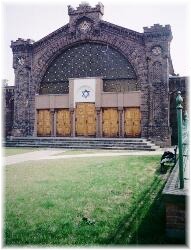
|
After the German occupation in 1939,
the cemetery became part of the eastern section of the enclosed Lodz ghetto.
A total of about 200,000 Jews were incarcerated in the ghetto. Between
1940 and 1944, approximately 43,000 burials took place in the spare part
of the cemetery that became known as the Pole Gettowe or Ghetto
Field. Many of those interred were victims of starvation, cold and
disease (especially typhus); they included Jews from Germany, Austria,
Czechoslovakia and Luxembourg, who were transported to the ghetto in 1941,
as well as Roma
(Gypsies) who died in the Gypsy Camp in the ghetto. The cemetery was the site of
mass executions of Jews, Roma and non-Jewish Poles: the
graves of the Polish scouts and soldiers of the Home Army are found
there. The Germans forbade the use of stone grave markers, so burial sites
were marked with metal bed frames or low cement posts. After the ghetto
was liquidated in August 1944, about 830 Jews were left as a clean-up crew.
They were forced to dig large holes for their own graves near the cemetery
wall. The Nazis did not have enough time to kill them, and the empty holes
have been left as a remembrance.
Right after WWII, Lodz became one
of the largest gathering places of Jewish survivors of concentration camps
and refugees from the U.S.S.R. This is the reason why so many graves from
the first post-war years can be found there. A
symbolic grave was constructed for 84
Jewish women from Lodz, from the Stutthof concentration camp, who were
murdered
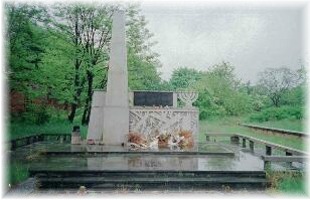
Monument to the victims of the Lodz Ghetto |
by the Nazis in 1945 near Wejherowo. In 1956, a monument
in memory of the victims of the Lodz ghetto by Muszko was erected at the
cemetery. It features a smooth obelisk, a menorah (an important symbol
of the Jewish nation), and a broken oak tree with leaves stemming from
the tree (symbolizing death, especially death at a young age). Also in
1956, the city authorities widened a road that reduced the southwest area
of the cemetery. Tombstones were moved and remain in locations other than
the original ones. The cemetery deteriorated and was vandalized over the
following decades.
|
The first attempts to protect the
cemetery were made in the mid-1970s. In 1980, the cemetery was registered
as an historical site. In 1995, the city of Lodz and the Organization
of Former Residents of Lodz in Israel established the Monumentum
Iudaicum Lodzense Foundation
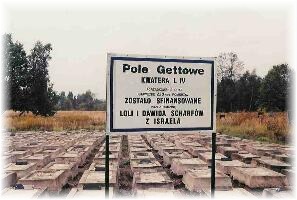
The Ghetto Field in the Lodz Cemetery, 1998. The
sign reads:
|
Pole
Gettowe, Kwatera
L IV
Porzadkowanie Oraz Ustawienie 250-CIU Pomników Zostalo
Sfinansowane przez Rodzinie
LOLI I DAWIDA
SCHARFÓW Z ISRAELA |
|
to preserve the cemetery and other remains
of Jewish culture in Lodz. In 1996, the World Restitution Organization
joined the foundation. In recent years, a project was begun to place low concrete markers
on the grave sites in the Ghetto Field. The Ghetto Field is marked by two
large Ohels -- a brick construction marking the graves of rabbis,
tzaddiks and spiritual masters of Chassidism -- covering the final resting
place of the rabbinical dynasty of Pabianice (see section "G-V" in
the cemetery plan) and the tzaddikim dynasty
from Sochaczew (see section "G-IV" in the
cemetery plan). Overgrown vegetation and moisture threaten the condition
of the tombstones and create a significant problem in negotiating one's
way through the cemetery. Recent efforts have focused on clearing vegetation
and leveling the ground, as well as restoration of specific tombstones
and mausoleums, the funeral home and the wall surrounding the cemetery.
 Indexing of the Lodz Cemetery is in progress. To see the names
and locations of those already indexed, go to the website for
the Jewish Lodz Cemetery and see the
cemetery plan. You can search all the burial plots at one time
through
Steve Morse's One Step website. Indexing of the Lodz Cemetery is in progress. To see the names
and locations of those already indexed, go to the website for
the Jewish Lodz Cemetery and see the
cemetery plan. You can search all the burial plots at one time
through
Steve Morse's One Step website.
|
The cemetery contains approximately
180,000 graves, marked by approximately 65,000 tombstones, ohels and mausoleums,
many of which are of architectural significance.
|
One hundred of these have been declared historical monuments and are in
various stages of restoration. The mausoleum of Izrael
and Eleanora Poznanski is perhaps the largest Jewish tombstone in the
world and the only one decorated with mosaics. The Monumentum Iudaicum Lodzense Foundation, recently
initiated the idea to make the cemetery a UNESCO
World Heritage Site. As a result, it has now been formally tabled in
the Polish parliament by the Polish minister of culture. The present size
of the cemetery is 42.5 hectares. It continues to function as a Jewish
burial site.
|
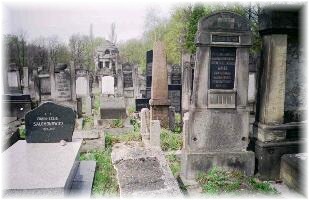
Tombstones in the Lodz Cemetery, with the domed
Poznanski mausoleum visible in the background |
The International
Jewish Cemetery Project entries for the old and new cemeteries in Lodz contain
reports on the physical condition of these sites and additional information.
Facts obtained from: Przewodnik
po Cmentarzu Zydowskim w Lodzi (A Guide to the Jewish Cemetery in Lodz),
1997, Lodz City Office, A Guide to Jewish Lodz, 1994, by Jerzy Malenczyk,
and other sources.
Records of the Cemetery
The extant records of the new cemetery,
from 1892 to August 1944, are an excellent source of genealogical information.
By viewing the father's name of the deceased, family relationships may
be easily identified. After finding records of individuals in the LDS
microfilm of Lodz, their burial location in the cemetery records
may also be found, if the individual died in, or after, 1892. In some instances,
the cemetery records can supplement information found in the ghetto list,
Lodz-Names: List
of Ghetto Inhabitants, 1940-1944, by supplying the father's name
of those in the ghetto list and buried in the cemetery. Some ghetto victims
whose names are not found at all in Lodz-Names:
List of Ghetto Inhabitants, 1940-1944 are found in the cemetery
records. This is evidence that the published ghetto records are an incomplete
list of all Jews incarcerated in the ghetto. Limitations of the cemetery
records are the lack of maiden names of married women and, occasionally,
missing father's names.
These valuable records are held by
two entities: the Jewish community
of Lodz and the Organization
of Former Residents of Lodz in Israel. The best way to obtain information
from these entities is an on-site visit, either by yourself or your representative.
Be prepared to offer a donation along with your request.
The
Jewish Community of Lodz
Mr. Symcha Keller
Gmina Wyznaniowa Zydowska
ul. Pomorska 18
Lodz 90-201, Poland
Phone: 48-42-6320427
Fax: 48-42-6335156
Mr. Symcha Keller is the Secretary
of the Jewish Community of Lodz. He has a large card file of, one hopes,
all the burials in the large cemetery now in use. Each card gives, at minimum,
the name of the person, his or her last address, and the location of the
grave. He, as well as the caretaker at the cemetery itself, has a large
chart of the graves.
|
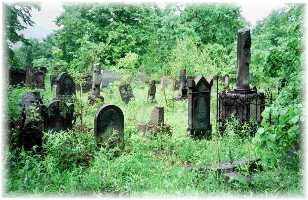
Tombstones in the Lodz Cemetery |
I visited
the cemetery in 1997. Once you get past the first several rows of graves,
which are on open ground, you enter a thicket, almost a jungle. The caretaker
put on hip boots before going there. Footing is precarious. Upheaval of
the ground here, and there, has thrown gravestones over. To find the grave
of one relative I had to keep reading headstones while the caretaker checked
against his chart. Back there, the alignment of the rows and columns is
not at all clear. At what had to be the grave site of my cousin, the stone
was lying on its face; we could not lift it.
- Arthur
S. Abramson
|
The
Organization of Former Residents of Lodz in Israel
158 Dizengoff Street
Tel Aviv 63461
Israel
Phone: 972-(0)3-524-1833
Fax: 972-(0)3-523-8126
This all volunteer group in Tel Aviv
maintains a database of those buried in the Lodz Jewish cemetery, between
approximately 1892 and the ghetto's liquidation in August 1944. This information
is printed in loose-leaf binders in alphabetical order. The burial list
includes an identification number, surname and first name(s), father's
name, age at death, date of death as year/month/day and exact site within
the cemetery and notes.
- Michael
J. Meshenberg
For more information, see:
Photos courtesy of Pawel B.
Dorman and Howard L. Rosen z"l
|